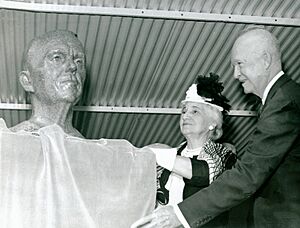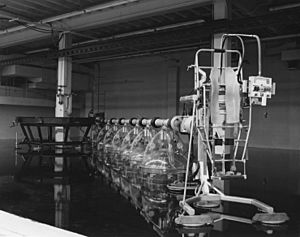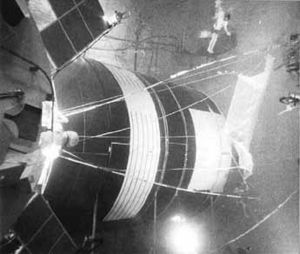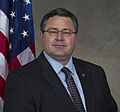Marshall Space Flight Center facts for kids
 |
|
 Aerial view of MSFC in 2016. Note that the buildings in the center of the image and on the right (4202 and 4200) have been demolished. |
|
| Agency overview | |
|---|---|
| Formed | July 1, 1960 |
| Preceding agency | |
| Jurisdiction | U.S. federal government |
| Headquarters | Redstone Arsenal, Madison County, Alabama 34°39′3″N 86°40′22″W / 34.65083°N 86.67278°W |
| Employees | 6,000, including 2,300 civil servants |
| Annual budget | $2 Billion |
| Agency executive |
|
| Parent agency | NASA |
The Marshall Space Flight Center (MSFC) is a big NASA center in Redstone Arsenal, Alabama. It's where the U.S. government works on rockets and spacecraft propulsion. This means they design and build the engines and systems that push rockets into space.
MSFC is the largest NASA center. Its first big job was to create the Saturn rockets for the Apollo program. These rockets helped send astronauts to the Moon!
Over the years, Marshall has led many important space projects. This includes the main engines and fuel tank for the Space Shuttle. They also worked on designing and building the International Space Station (ISS). Today, they are a key part of the Space Launch System (SLS) rocket. The center is named after George C. Marshall, a famous U.S. Army General.
Inside MSFC, there's a special place called the Huntsville Operations Support Center (HOSC). This center helps with International Space Station activities. It also watches rocket launches from Cape Canaveral Space Force Station when MSFC has equipment on board.
Contents
History of Space Exploration at Marshall
MSFC has always been a leader in developing rocket engines and space technology. In the 1960s, a lot of work went into the Apollo Program. This is when the powerful Saturn rockets were designed and tested here. After Apollo, MSFC played a big role in projects like Skylab, the Space Shuttle, and Spacelab. These projects used the Space Shuttle's cargo bay for experiments.
Starting with Rockets
After World War II ended in 1945, the U.S. brought many German scientists and engineers to America. This was part of a plan to learn about advanced military technologies. In 1945, 127 missile experts, led by Wernher von Braun, started working for the U.S. Army. Most of them had worked on the V-2 missile in Germany.
For five years, von Braun and his team improved the V-2 missile for U.S. use. They tested rockets at White Sands Missile Range in New Mexico. They even combined a V-2 with another rocket to reach a record height of 250 miles (400 km).
In 1949, the Army moved its rocket research to Redstone Arsenal in Huntsville, Alabama. Von Braun's group, about 1,000 people, moved there in 1950. They started working on a new missile called the PGM-11 Redstone.
Von Braun always dreamed of space. In 1954, he suggested using the Redstone rocket to launch satellites. But the U.S. decided to use a different rocket, called Vanguard, for its first satellite program.
In 1956, the Army Ballistic Missile Agency (ABMA) was formed. They worked on the PGM-19 Jupiter missile. They also developed the Jupiter-C rocket, which was a modified Redstone.
Then, on October 4, 1957, the Soviet Union launched Sputnik 1. This was the first satellite to orbit Earth. The U.S. tried to launch its own satellite, but it failed. Finally, on January 31, 1958, von Braun's team used a Jupiter C rocket to launch Explorer 1. This was the first successful U.S. satellite!
In 1958, the Army started a program to build a very large rocket. This rocket, called Saturn, would have 1.5 million pounds of thrust.
On July 29, 1958, President Dwight D. Eisenhower created the National Aeronautics and Space Administration (NASA). NASA would lead all non-military space activities. In 1959, the Saturn rocket program was moved to NASA.
In 1959, two monkeys, Able and Miss Baker, became the first living creatures recovered from space. They flew on a Jupiter missile to an altitude of 300 miles (480 km). This was part of Project Mercury, which aimed for human spaceflight. In October 1959, all Army space activities were transferred to NASA.
Marshall Space Flight Center is Born
On July 1, 1960, the Marshall Space Flight Center (MSFC) was officially created. It took over from the old Redstone Arsenal. Wernher von Braun became MSFC's first NASA Director. About 4,670 employees and many buildings were transferred to the new center.
President Eisenhower spoke at the dedication ceremony on September 8, 1960. He honored George C. Marshall, for whom the center was named. Von Braun's team, who had worked with him since before World War II, became the technical leaders at MSFC. They were very skilled and helped make many projects successful.
MSFC's first big project was preparing a Redstone rocket for Project Mercury. On May 5, 1961, Alan Shepard became the first American in space. He flew a sub-orbital flight, meaning he went into space but didn't orbit Earth.
By 1965, MSFC had about 7,500 government employees. Many other companies also worked at MSFC, helping with rocket development.
Saturn Rockets for the Moon
On May 25, 1961, President John F. Kennedy announced a bold goal. He wanted the U.S. to land a person on the Moon by the end of the decade. MSFC's main job for the Apollo program was to develop the powerful Saturn rockets.
This meant creating three new liquid-fueled rocket engines: the J-2, F-1, and H-1. The F-1 engine was incredibly powerful. Each one produced 1.5 million pounds of thrust!
The first rocket, Saturn I, was tested on October 27, 1961. Its first stage had eight H-1 engines. The second stage had six LR10A-3 engines. Ten Saturn I rockets were used for testing Apollo spacecraft parts.
The Saturn IB was an improved version. Its second stage had a single, more powerful J-2 engine. This engine could also be restarted in space. The Saturn IB was first tested on February 26, 1966. It was used for both uncrewed and crewed missions.
The Saturn V was the most important rocket for the Apollo Program. It was the largest and most powerful rocket ever used. The Saturn V had three stages and an instrument unit. The first stage had five F-1 engines, giving a total of 7.5 million pounds of thrust! The second stage had five J-2 engines, and the third stage had one J-2 engine.
The Saturn V Instrument Unit was the "brains" of the rocket. It contained the guidance system, computers, and other electronics. This unit was the only full Saturn part made in Huntsville.
The first Saturn V test flight was on November 9, 1967. On July 16, 1969, a Saturn V launched Apollo 11 to the Moon. This was a huge achievement! Saturn V rockets continued to launch Apollo missions until 1972. The last Saturn V flight was in 1973 for the Skylab program. In total, 15 Saturn V rockets were built, and 13 worked perfectly.
Building and Testing Rockets
Wernher von Braun believed that engineers should help build and test the rockets they designed. So, MSFC had facilities to build prototypes of every Saturn rocket. They used large computers for checking everything.
Special test stands were built for the rockets. The Saturn V Dynamic Test Stand, finished in 1964, was 475 feet (145 m) tall. It could hold an entire Saturn V rocket for testing. The S1C Static Test Stand was for firing the five F-1 engines of the first stage. These tests created earthquake-like rumbles that could be heard 100 miles (160 km) away!
In 1961, the Michoud Rocket Factory in Louisiana was chosen to build Saturn V rockets. A large area in Mississippi, later called the John C. Stennis Space Center, was used to test these rockets.
Early Science in Space
MSFC has always done a lot of science and engineering research. Two early projects, Highwater and Pegasus, used the Saturn I rocket during its test flights.
In Project Highwater, a dummy rocket stage was filled with 23,000 gallons (87,000 liters) of water. When the first stage burned out, explosives released the water into the upper atmosphere. This helped scientists understand what would happen if a rocket broke apart high up.
The Pegasus satellite program studied tiny space rocks called micrometeoroids. The Saturn I second stage carried two large panels that unfolded in orbit. These panels had sensors to detect micrometeoroids. Three Pegasus satellites were launched in 1965 and stayed in orbit for many years.
Exploring the Moon
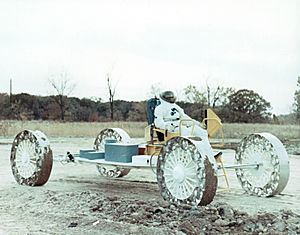
Six Apollo missions landed on the Moon: Apollo 11, 12, 14, 15, 16, and 17. Apollo 13 had problems and only circled the Moon. Most missions carried an Apollo Lunar Surface Experiments Package (ALSEP) with scientific equipment. MSFC scientists helped with these experiments.
The Lunar Roving Vehicle (LRV), or "Moon Buggy," was developed at MSFC. It helped astronauts explore more of the Moon's surface. LRVs were used on the last three Apollo missions. They allowed astronauts to cover an area similar in size to Manhattan Island. Astronauts used them to carry scientific tools and bring back over 200 pounds (90 kg) of Moon rocks.
Skylab: America's First Space Station
The Apollo Applications Program (AAP) planned to use leftover Apollo equipment for science missions. One idea was an orbital workshop. In 1965, MSFC was given the job of developing this workshop.
In 1968, MSFC opened the Neutral Buoyancy Simulator. This was a 75-foot (23 m) wide water tank. Engineers and astronauts used it to practice working in weightlessness, like in space. This was especially useful for practicing spacewalks.
The Orbital Workshop was built from a Saturn V rocket stage. It was renamed Skylab in 1970. MSFC was in charge of building Skylab and making sure all its systems worked together.
Another AAP project was the Apollo Telescope Mount (ATM). This was a solar observatory designed to study the Sun. It was added to Skylab. The ATM had eight instruments to observe the Sun in different light wavelengths. Astronauts had to change photographic film during spacewalks.
On May 14, 1973, the 77-ton (70,000 kg) Skylab was launched into orbit by the last Saturn V rocket. Astronaut crews were launched to Skylab using Saturn IB rockets. Skylab was damaged during launch, but the first crew repaired it. Three crews lived on Skylab for a total of 171 days. Skylab, including the ATM, collected about 2,000 hours of data from 300 science and medical experiments.
Apollo–Soyuz Test Program
The Apollo–Soyuz Test Project (ASTP) was the last flight of a Saturn IB rocket. On July 15, 1975, a U.S. crew launched into space. They docked with a Soviet Soyuz spacecraft. This mission helped both countries learn how to work together in space. It was the last U.S. crewed mission until 1981.
Space Shuttle Development

On January 5, 1972, President Richard M. Nixon announced plans for the Space Shuttle. This was a reusable system to make space travel more routine. The Shuttle had three main parts: the Orbiter (where the crew and cargo were), two Solid Rocket Boosters (SRBs), and the External Tank (ET) for fuel.
MSFC was responsible for the SRBs, the Orbiter's three main engines, and the ET. They also helped with Spacelab, a European laboratory carried in the Shuttle's cargo bay.
The first test firing of an Orbiter main engine was in 1975. Two years later, the first SRB was tested. In 1977, the first Orbiter, Enterprise, flew attached to a plane. Later, it made free landings. In 1978, Enterprise was brought to MSFC. It was placed on the modified Saturn V Dynamic Test Stand for vibration tests.
The first Space Shuttle, Columbia, was launched on April 12, 1981. This was the first orbital test flight.
The Space Shuttle Era: 1980s and 1990s
The Space Shuttle was a very complex spacecraft. MSFC managed the development of its propulsion systems. Engineers at MSFC monitored every Shuttle launch from the Huntsville Operations Support Center. They helped solve any problems with the Shuttle's engines.
The first Shuttle flight, STS-1, verified the system's performance. Many more flights followed, deploying satellites and conducting experiments.
On January 28, 1986, the Space Shuttle Challenger launched on mission STS-51-L. Sadly, it broke apart shortly after launch, and the crew was lost. Investigations showed that a seal (O-ring) in one of the solid rocket boosters failed. Cold weather was a factor. MSFC led the redesign and testing of the SRBs. Shuttle flights resumed in September 1988.
Shuttle Missions and Payloads
Space Shuttles carried many different payloads. These included scientific research equipment and military satellites. MSFC was responsible for integrating these experimental payloads.
Experiments were carried on pallets in the Shuttle's cargo bay. Some missions carried 12 standard containers for smaller experiments. These were part of the Getaway Special (GAS) program. GAS flights were offered at low cost to universities and companies.
Spacelab: A Lab in Space
Many experiments were done on Spacelab. This was a reusable laboratory with different parts, including a pressurized module. Ten European nations worked with MSFC to design and build the first Spacelab. Japan also funded a Spacelab mission.
Spacelab components flew on 22 Shuttle missions over 15 years. The last flight was in April 1998.
- Spacelab 1 launched on November 28, 1983. It was the first Shuttle flight with six astronauts. They did 73 experiments in many fields, like astronomy and life sciences.
- U.S. Microgravity Laboratory 1 (USML-1) launched in June 1992. During 14 days, 31 microgravity experiments were completed.
In the early 1990s, MSFC took over control of all Spacelab missions.
International Space Station
NASA started planning a space station in 1984. In 1993, plans from different countries were combined into one International Space Station (ISS). The ISS is made of modules assembled in orbit. The first U.S. module, Unity, was built by Boeing at MSFC facilities.
ISS assembly continued for many years. Astronauts have lived on the station continuously since February 7, 2001. In October 2007, Harmony (Node 2) was added. This module, also managed by MSFC, provided connections for European and Japanese modules. It also added more living space, allowing the ISS crew to grow to six people. The last major U.S. part was delivered in February 2009. This completed the United States Orbital Segment (USOS) of the station.
Hubble Space Telescope
In the 1960s, early space observatories showed how valuable telescopes in space could be. This led to plans for the Large Space Telescope (LST). Congress funded the LST in 1978.
MSFC was responsible for designing and building the telescope itself. The mirrors were made by Perkin-Elmer. The LST was renamed the Hubble Space Telescope in 1983.
The Hubble Space Telescope was launched in April 1990. But it sent back blurry images because of a problem with its main mirror. Luckily, Hubble was designed to be fixed in space. In December 1993, astronauts flew to Hubble to make repairs. More repair missions followed in 1997, 1999, 2002, and 2009. These missions greatly improved Hubble's performance. Astronauts practiced these repairs in MSFC's Neutral Buoyancy Facility.
Chandra X-Ray Observatory
Even before the Einstein Observatory launched in 1978, MSFC began planning a larger X-ray telescope. In 1976, an X-Ray Test Facility was built at MSFC. This unique facility tests and calibrates X-ray mirrors and telescopes. MSFC was given the job of designing and building this new telescope, called the Advanced X-ray Astrophysics Facility (AXAF).
AXAF was renamed Chandra X-ray Observatory in 1998. It launched on July 23, 1999, on the Space Shuttle Columbia. An Inertial Upper Stage booster, adapted by MSFC, carried Chandra to its high orbit. Chandra has been sending back amazing data about the high-energy universe ever since. It helps astronomers see star clusters, supernova remnants, and galaxy collisions.
Compton Gamma Ray Observatory
The Compton Gamma Ray Observatory (CGRO) was another of NASA's "Great Observatories." It launched on April 5, 1991. At 37,000 pounds (16,780 kg), it was the heaviest astrophysics payload at the time.
Gamma rays are the highest energy form of light. They come from powerful events in space, like exploding stars. The CGRO was designed to detect these gamma rays.
MSFC was responsible for the Burst and Transient Source Experiment (BATSE) on CGRO. BATSE detected sudden bursts of gamma rays. In nine years, BATSE recorded about 8,000 events. Many of these strong bursts came from distant galaxies.
Unlike Hubble, CGRO was not designed for repairs in space. After one of its gyroscopes failed, NASA decided to bring it down safely. On June 4, 2000, it was guided to fall harmlessly into the Pacific Ocean.
Space Exploration Today: 2010s Onward
Marshall Space Flight Center continues to support NASA's mission in three key areas. These are: launching from Earth (Space Vehicles), living and working in space (International Space Station), and understanding our world (Advanced Scientific Research).
International Space Station Operations
The International Space Station is a project with the United States, Russia, Europe, Japan, and Canada. Astronauts have lived on the station continuously since November 2, 2000. It orbits Earth 16 times a day, about 250 miles (400 km) up. The station weighs over 932,000 pounds (422,700 kg). A crew of six lives and works there, doing research and preparing for future space travel.
The ISS is planned to operate at least until the end of 2030. After the Space Shuttle retired in 2011, U.S. astronauts traveled to the ISS on Russian Soyuz spacecraft. Since 2020, NASA's Commercial Crew Program has launched astronauts on SpaceX Crew Dragon spacecraft. Boeing's CST-100 Starliner spacecraft will also join soon.
MSFC supports activities on the ISS through its Payload Operations and Integration Center (POC). This center links researchers on Earth with their experiments and astronauts on the ISS. It operates 24/7. As of March 2011, the POC had coordinated over 1,100 experiments. These were done by 41 crew members over 6,000 hours of science research.
Advanced Scientific Research
Many experiments have been done on the International Space Station. The amazing images from the Hubble Space Telescope and the Chandra X-ray Observatory are possible thanks to MSFC. MSFC designed and built these telescopes. It also has the only facility in the world for testing large telescope mirrors in a space-like environment.
Work is ongoing for the James Webb Space Telescope (JWST). This telescope will have the largest primary mirror ever assembled in space. In the future, MSFC's facility might be used for another telescope, the Advanced Technology Large-Aperture Space Telescope (AT-LAST).
The National Space Science and Technology Center (NSSTC) is a joint research effort. It brings together NASA and seven Alabama universities. Its goal is to encourage research collaboration between government, schools, and industry. It has seven research centers, including Advanced Optics and Space Science.
Exploring Our Solar System
Teams at MSFC manage NASA's programs for exploring the Sun, Moon, planets, and other objects in our Solar System. This includes Gravity Probe B, which tested parts of Einstein's theory of relativity. They also worked on Solar-B, a mission to study the Sun's magnetic field. MSFC's Lunar Precursor and Robotic Program Office manages projects for robotic lunar exploration.
Studying Earth's Climate and Weather
MSFC also develops systems to monitor Earth's climate and weather. At the Global Hydrology and Climate Center (GHCC), researchers combine data from Earth systems and satellites. They study climate change and biodiversity. This information helps improve agriculture, city planning, and water management.
Microsatellites: Small but Mighty
On November 19, 2010, MSFC launched its first microsatellite, FASTSAT. This small satellite, weighing under 400 pounds (180 kg), carries multiple experiments into low-Earth orbit. It allows for low-cost science and technology research in space. FASTSAT was developed at MSFC with partners in Huntsville, Alabama.
FASTSAT carried six experiments. One was NanoSail-D2, a nanosatellite. It was the first satellite launched from another satellite. It successfully deployed on January 21, 2011.
Leaders of Marshall Space Flight Center
Here are the people who have served as the director of the Marshall Space Flight Center:
| No. | Image | Director | Start | End | Refs. |
|---|---|---|---|---|---|
| 1 |  |
Wernher von Braun | July 1, 1960 | January 27, 1970 | |
| 2 |  |
Eberhard F. M. Rees | March 1, 1970 | January 19, 1973 | |
| 3 |  |
Rocco A. Petrone | January 26, 1973 | March 15, 1974 | |
| 4 |  |
William R. Lucas | June 15, 1974 | July 3, 1986 | |
| 5 |  |
James R. Thompson Jr. | September 29, 1986 | July 6, 1989 | |
| 6 |  |
Thomas J. Lee | July 6, 1989 | January 6, 1994 | |
| 7 |  |
Gene Porter Bridwell | January 6, 1994 | February 3, 1996 | |
| 8 |  |
J. Wayne Littles | February 3, 1996 | January 1998 | |
| Acting |  |
Carolyn S. Griner | January 1998 | September 1998 | |
| 9 |  |
Arthur G. Stephenson | September 1998 | May, 2003 | |
| 10 |  |
David A. King | June 15, 2003 | March 26, 2009 | |
| Acting |  |
Robert M. Lightfoot, Jr. | March 26, 2009 | July 2009 | |
| 11 | August 2009 | March 4, 2012 | |||
| Acting |  |
Arthur E. Goldman | March 5, 2012 | August 3, 2012 | |
| Acting |  |
Robin Henderson | August 4, 2012 | September 24, 2012 | |
| 12 |  |
Patrick Scheuermann | September 25, 2012 | November 13, 2015 | |
| Acting |  |
Todd May | November 14, 2015 | January 31, 2016 | |
| 13 | February 1, 2016 | July 27, 2018 | |||
| Acting |  |
Jody Singer | July 27, 2018 | September 12, 2018 | |
| 14 | September 13, 2018 | July 29, 2023 | |||
| Acting | Joseph Pelfrey | July 29, 2023 | February 5, 2024 | ||
| 15 | February 5, 2024 | present |
Images for kids
See also
 In Spanish: Centro Marshall de vuelos espaciales para niños
In Spanish: Centro Marshall de vuelos espaciales para niños
- US Space and Rocket Center
- Redstone Arsenal
- Test Stand 4670



